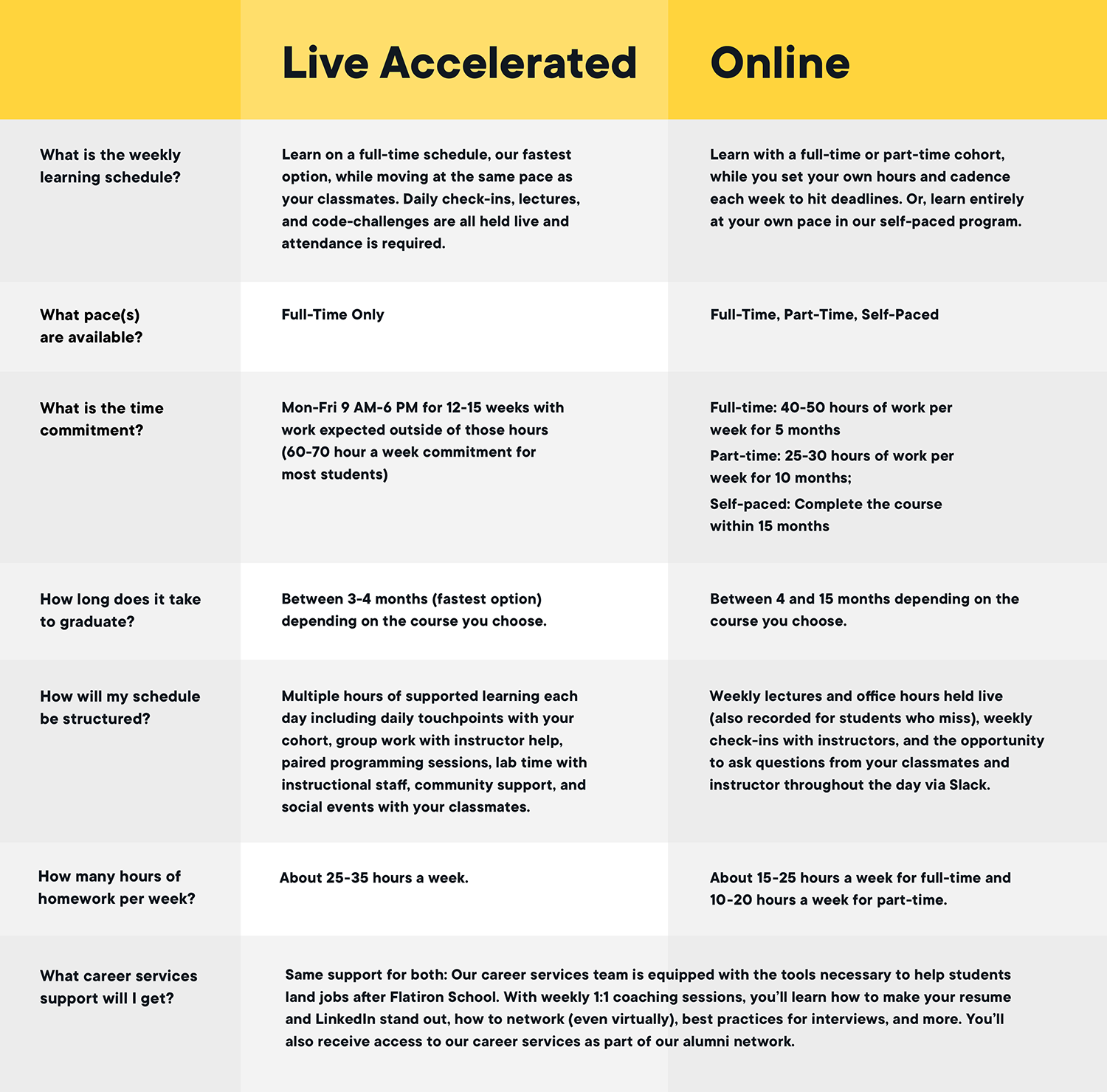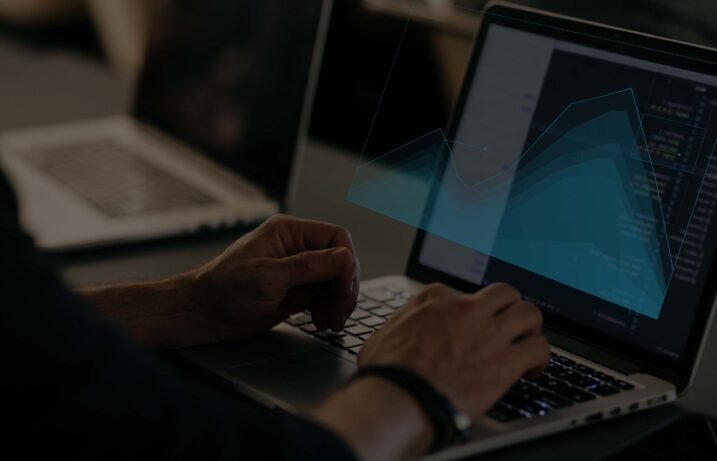See the latest information regarding Flatiron School's COVID-19 response and our reopening plans.
Wondering what our campus-based virtual courses are looking and feeling like in these days of social distancing? We’ve compiled a list of our most frequently-asked questions so students can understand what our Live Accelerated courses look and feel like, and how they differs from our online learning experiences. Check it out below!
How is the Live Accelerated learning experience different from our online program?
Virtual Live Accelerated programs are shorter in duration so you graduate more quickly; the schedule is also more intense and less flexible than our online courses. In our live accelerated courses, you’ll learn directly alongside your classmates and instructors in daily Zoom meetings, similar to our on campus experience. These sessions include morning and evening syncs, open zoom rooms for lab work, high-participation Live Acceleratd lectures, lunch hangouts, and more. By comparison, our online programs are longer in duration, offer more flexibility. Online programs range in duration (from 5 months to 15 months, depending on the pace chosen), and operate with a mostly asynchronous learning environment.
What’s the Live Accelerated schedule each day?
We usually get started between 9-9:30am and everyone logs into a Zoom link. We do what we call a ‘stand up’ to start the day and a ‘stand down’ to end each day. This gives us an opportunity to preview what the day will look like and align on the activities and goals and then to review at the end of the day. You will know what time and what link to use for the daily stand up. It’s good to have your camera on (even if you have bedhead!) so we can all see one another. It’s really hard to engage with a black square.
Campus staff will take attendance and outline what will happen that day. Throughout the day, there will be the same lectures as if you were on campus, only the instructor might be teaching from their kitchen. You’ll take notes, ask questions, just like you would in the classroom. Often students post questions in a chat so the teacher can pause and answer them as they come up. The day is filled with individual work, group work, interaction with instructors on an as needed basis, and office hours. Every day is different, but a sample day is below.
Sample Day
9 a.m. — Student-led discussion
Your day begins with an open discussion when you can ask questions, review new skills, and program materials from the day before to ensure you’re up to speed.
10 a.m. — Lecture
Learn key concepts from your expert instructor through interactive exercises and collaborative discussion.
1 p.m. — Pair-programming exercises
Work together with a partner to build your strategic and tactical coding skills and learn from one another.
4 p.m — Labs & mini projects
Self-led labs let you explore your own coding projects based on the material from lecture. Learn from professors, then immediately put what you learned into action. Making things is the best way to learn things.
6 p.m. — Homework
You’ll end the day reviewing concepts and strategizing the next steps in your personal projects.
How are you maintaining the in-person experience remotely?
The Live Accelerated experience looks a lot like the regular campus experience, but we are doing it all on Zoom. The schedule is the same, the people are the same, the expectations are the same. The biggest difference is that we have added more intentional engagement activities to give students an opportunity to get to know their classmates and instructors in this environment. It’s still an immersive, supportive learning experience.
We are also surveying students and staff every week to gauge what is working and where students might need more support. That real-time feedback enables us to react quickly.
Our Live Accelerated courses have a range of virtual support systems, including instructors, coaches, and student community. Learn from a diverse and experienced community as you work towards learning and launching a new career.
How often do I meet with my class?
Every day, just like on campus. Instead of walking into campus and grabbing a coffee in the kitchen, you’ll get one from your kitchen and log into your Zoom link where you’ll see the familiar faces of your classmates.
How do you build community online?
We will be sharing the class Slack channel with you even before you start classes. We really encourage you to participate in the questions and activities to get to know your classmates ahead of time and to get your questions answered. In addition to scheduled face to face interaction in group projects, we have found that the most successful students use Slack to reach out to fellow students throughout the day. Many also schedule Zoom time with fellow students to mimic that face to face time they’d have in person. We’ve even continued to schedule programming and events with the community but in a remote environment. We’ve hosted panel discussions, project showcases and even graduations — all online.
Am I working on Zoom all day?
Each day is different but we start and end with Zoom and it’s our best tool for being connected face to face. There will be days where you might log out and work independently for a time then log back in and discuss your progress. And there will be days where you are mostly on Zoom all day. We know this is an unusual time with many of us juggling partners and roommates and families in the same space, so if you need to pop out and back on, that’s OK. The important thing is that we are communicating with one another.
What if I don’t like being on camera?
No one loves it but it becomes a new normal. Having your camera on and showing you are engaged is just a matter of participation and respect for the others who are doing the same thing. Lecturing in person allows the instructor to see faces and body language and get a sense of if the information is being absorbed. That’s harder when all we see is a face, but it’s also why it’s so important to have your camera on. The same is true for any Zoom meeting. Additionally, we are preparing you for a remote work environment. Many companies allow their employees to work from home at least once or twice a week, and learning virtually now will give you the practice and experience that you can speak to when asked in a job interview if you’ve ever done so before.
Students very rarely spend all day on camera/on Zoom. When students are pair programming they're likely to spend much more time on camera chatting with their partner. Students will hop on Zoom if they need help/want to connect with someone, for some standups/stand downs, if they have a lecture, or if they have an orientation activity/guest speaker. Otherwise you are programming/working on labs and completing assignments.
How can I expect to work with my teachers?
You will work with your teachers virtually just like you would on campus. They will take attendance and set you up for the day. They will be delivering lectures and answering questions throughout the day. Depending on your needs and the needs of your classmates, they might schedule office hours for you to pop into so you can discuss what’s top of mind, or 1:1s with you to review your personal progress. You will have a clear roadmap of how to reach them throughout your school day, and students are encouraged to proactively reach out to communicate their needs.
What’s the remote experience like for lectures?
We practice constructivism, or the education philosophy where you learn hands on. One aspect of lecture is, of course, information dissemination, but another is for the teachers to gauge your understanding. Hence, your participation in lectures is even more critical while we are remote — this means keeping your camera on to stay engaged and to ask and answer questions. Come with labs done and questions ready!
How do you do pair programming or group work in a remote setting?
There are many tools we can use to support collaboration in a remote space. Depending on the needs of the class and the students, we may use Slack, Zoom breakout groups, or individual Zoom links. Often, for pair programming, pairs are assigned and will start a Slack call or Zoom call of their own, work together there, and tag a coach if they need help.
In other cases, we may put you in what’s called a breakout group. This is a Zoom session within the main Zoom call with a smaller subset of participants where you may share your screen with the person with whom you are pairing. Same setup for working in groups, we use breakout groups in Zoom to simulate the feeling of sitting at the same table on campus. While in a breakout group, the instructor or coach can pop in to check on how you’re doing, or you can send a question to them to request they pop in to your breakout group.
How is this different from the online program?
Here’s a chart breaking down some of the major differences between our Campus and Online programs:

How do I know if Full-Time Online or In-Person Live Accelerated is right for me?
The in-person scheduling has advantages in speed and structure. If you are not strong at setting a schedule for yourself and sticking to it, or you want to finish in the fastest possible time, the in-person virtual course is probably a better fit. If you are capable of meeting the time commitment and also need some flexibility, full-time online will be a better fit.
What is Flatiron’s response to the uncertain hiring market?
While hiring has slowed, the well is nowhere near dry. The tech job market is not immune to the economic impact of COVID-19, but it’s buoyed by the fact that most tech jobs can be done remotely, and by the fact that society is leaning on technology more than ever to stay connected and get business done in a socially-distanced world.
There are fewer opportunities right now, so candidates need to bring an even sharper skill set to those opportunities, but we're there to help students put in the extra effort. Some of our employer partners are putting in place hiring freezes or delays, but others are continuing to hire, so our employer partnerships team is pivoting based on new information all the time. We've seen some industries pretty hard hit while other ones are carrying on. We've seen different trends by company size, as well. Having a Career Services team on your side during this uncertainty means you are better able to pivot as well.
What’s the biggest change to the job search now that everything has moved online?
One of the biggest changes that students are making in their job search strategy is of no surprise: they no longer have in-person meetup opportunities. Research tells you that 80% of new jobs filled were never posted, so networking is a huge part of the job search. We always say that people hire people, job boards don't hire people.
Networking has moved from Meetup events, conferences, networking coffees, or in-person informational interviews to the virtual equivalent of all of those things. We have a weekly digest that we send to students that links to remote events. And many remote events are being opened up without geographic borders, which is cool!




